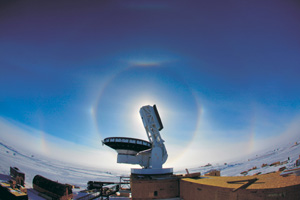Telescope fixes itself on South Pole skies in search of clues to explain universe’s composition, evolution
By Steve KoppesNews Office
 Surrounded by Antarctica’s pristine beauty, the South Pole Telescope is ready to scan the skies now that the SPT team, led by John Carlstrom, has collected the instrument’s first test observations. The SPT project will involve looking for clues to unravel the mysteries about the nature and origin of dark energy, an unknown force that dominates the universe. Before its arrival at the South Pole, the telescope was test-assembled in Kilgore, Texas, then dismantled and shipped by boat to New Zealand, and then flown to the South Pole, where it was reassembled. | |
Scientists aimed the University’s South Pole Telescope at Jupiter on Friday, Feb. 16, and successfully collected the massive instrument’s first test observations. Soon, a far more distant quarry will fall under the telescope’s sights as the team tackles one of the biggest mysteries to beset modern cosmologists—the nature and origin of dark energy.
“The telescope, camera and optics are all working as designed,” said John Carlstrom, the S. Chandrasekhar Distinguished Service Professor in Astronomy & Astrophysics and the College, who heads the SPT team. “First light with the SPT is a major milestone for the project and is a fitting conclusion to a remarkably productive summer season for the South Pole Station. We now look forward to fully characterizing the instrument and beginning cosmological observations,” he said.
The SPT is designed to pierce the mystery behind dark energy, an unknown force that dominates the universe. The solution to that mystery will determine whether what Einstein considered his greatest blunder was actually one of his greatest achievements.
Astrophysicists know the universe has been expanding since the big bang occurred 13.8 billion years ago. In the late 1990s, astronomers using exploding stars as cosmic tape measures discovered that the expansion of the universe is accelerating. This led to the idea that dark energy pushes the universe apart, overwhelming gravity, the attractive force exerted by all matter in the universe.
Primary funding for the $19.2 million SPT comes from the National Science Foundation, with additional support from the Kavli Foundation of Oxnard, Calif., and the Gordon and Betty Moore Foundation of San Francisco.
The telescope stands 70-feet tall, measures 33-feet across and weighs 280 tons. It was test-assembled in Kilgore, Texas, then taken apart, shipped by boat to New Zealand, and flown to the South Pole. Since November, the SPT team has worked furiously to reassemble and deploy the instrument.
The cold, dry atmosphere above the South Pole allows the telescope to more easily detect the cosmic microwave background radiation, or the CMB, the afterglow of the big bang, with minimal interference from water vapor. On the electromagnetic spectrum, the CMB falls somewhere between heat radiation and radio waves.
 The South Pole Telescope team poses for a photo. | |
Though largely uniform, the CMB contains tiny ripples of varying density and temperature. These ripples reflect the seeds, which, through gravitational attraction, grew into the galaxies and galaxy clusters visible to astronomers in the sky today. The SPT’s first key project will be to study small variations in the CMB to determine if dark energy began to affect the formation of galaxy clusters by overwhelming gravity over the last few billion years.
Galaxy clusters are groups of galaxies, the largest celestial bodies that gravity can hold together. “Our galaxy, the Milky Way, is in one of these clusters,” said Stephan Meyer, Professor in Astronomy & Astrophysics and the College. “And these clusters of galaxies actually change with time.”
The CMB allows astronomers to take snapshots of the infant universe, when it was only 400,000 years old. No stars or galaxies had yet formed. If dark energy changed the way the universe expanded, it would have left its “fingerprints” in the way that it forced galaxies apart over the deep history of time. Different causes would produce a different pattern in the formation of galaxy clusters.
According to one idea, dark energy could be Einstein’s cosmological constant: a steady force of nature operating at all times and in all places. Einstein introduced the cosmological constant into his theory of general relativity to accommodate a stationary universe, the dominant idea of the day. After astronomers discovered that the universe was actually expanding, he called the idea his greatest blunder.
If Einstein’s idea is correct, scientists will find that dark energy was much less influential in the universe five billion years ago than it is today. “Clusters weren’t around in the early universe. They took a long time to evolve,” Carlstrom said.
Another form of dark energy, called quintessence, suggests a force that varies in time and space. Some scientists even suggest that there is no dark energy, and that gravity merely breaks down on vast intergalactic scales.
To pinpoint when dark energy became important, the SPT will use a phenomenon called the Sunyaev-Zeldovich effect. This effect distorts the CMB as it passes through the hot gas of intervening galaxy clusters. As the microwaves interact with gas in the clusters, some of the microwaves change in frequency. The SPT will measure the slight temperature difference associated with the frequency change and produce an image of the gas in the cluster.
The SPT can scan large regions of the sky quickly. Scientists expect it to detect thousands or even tens of thousands of galaxy clusters within a few years. “To get a meaningful constraint on dark energy through measuring galaxy clusters, you need something like this South Pole Telescope for the S-Z work,” Carlstrom said. “The cluster S-Z signals cover small patches of sky relative to the intrinsic variations in the cosmic microwave background. To get some resolution, you need a big telescope. Now we have one.”
![[Chronicle]](/images/sidebar_header_oct06.gif)